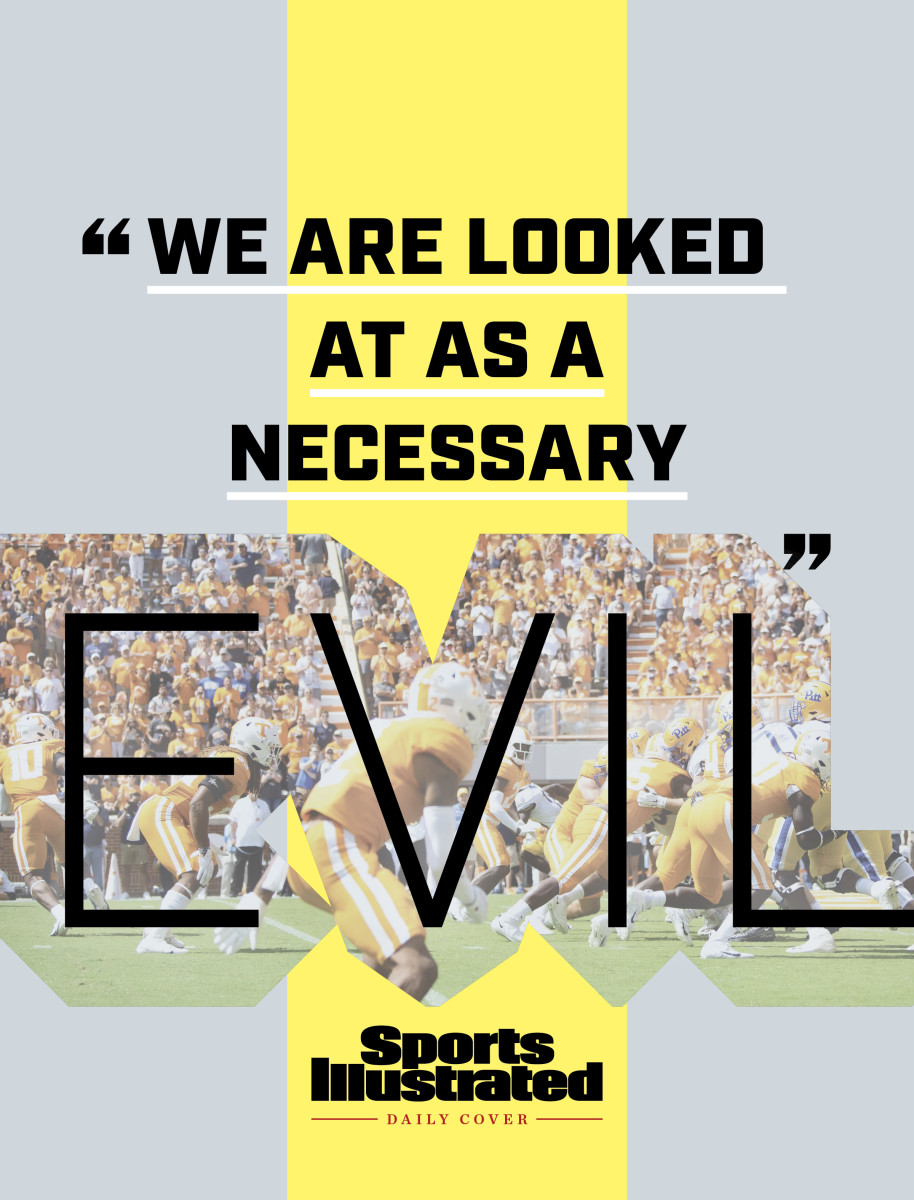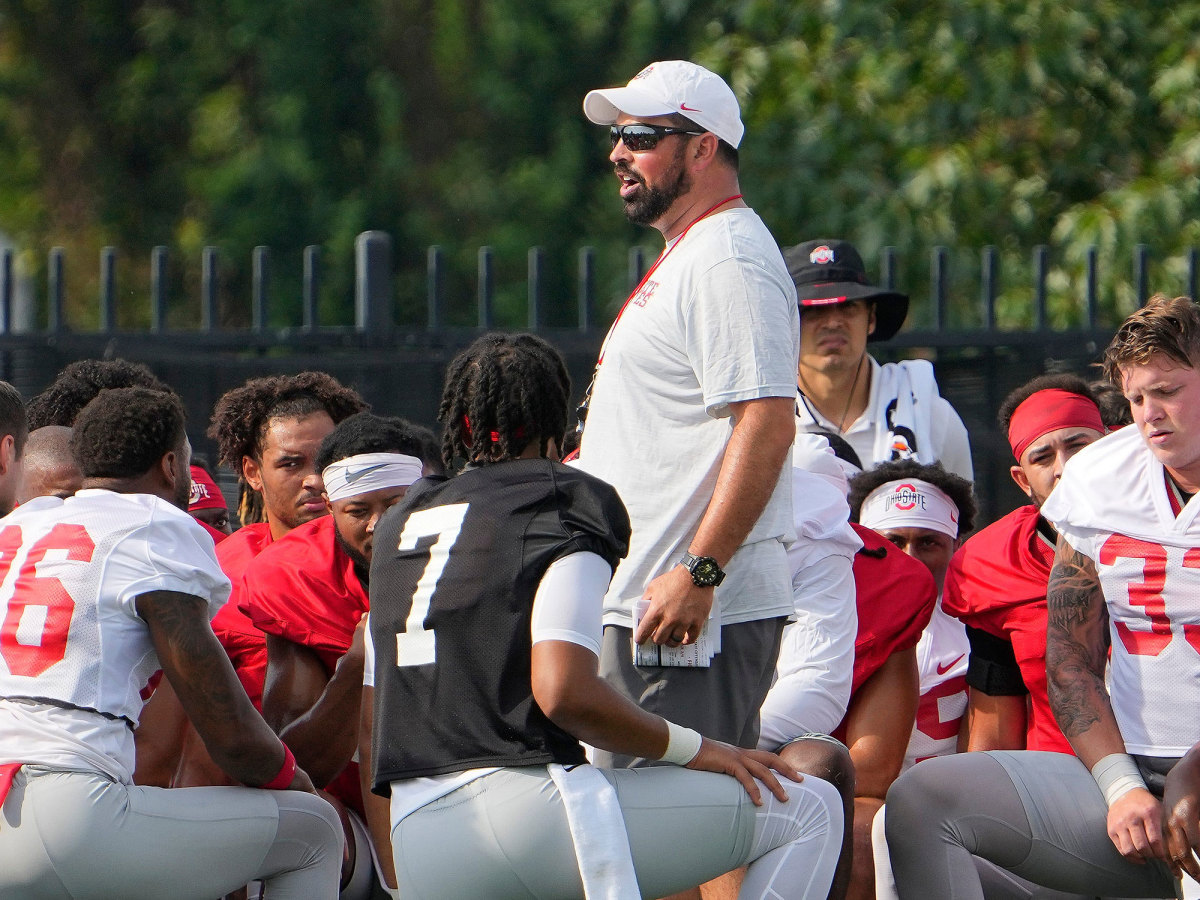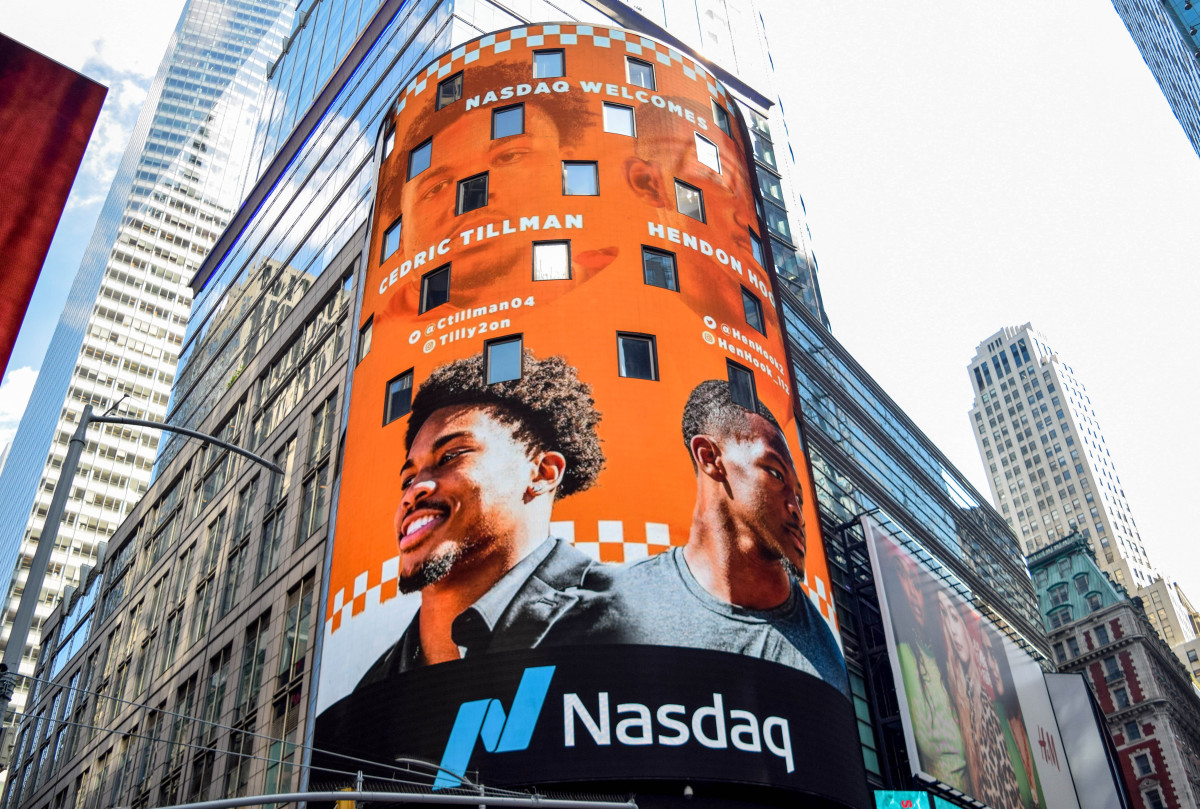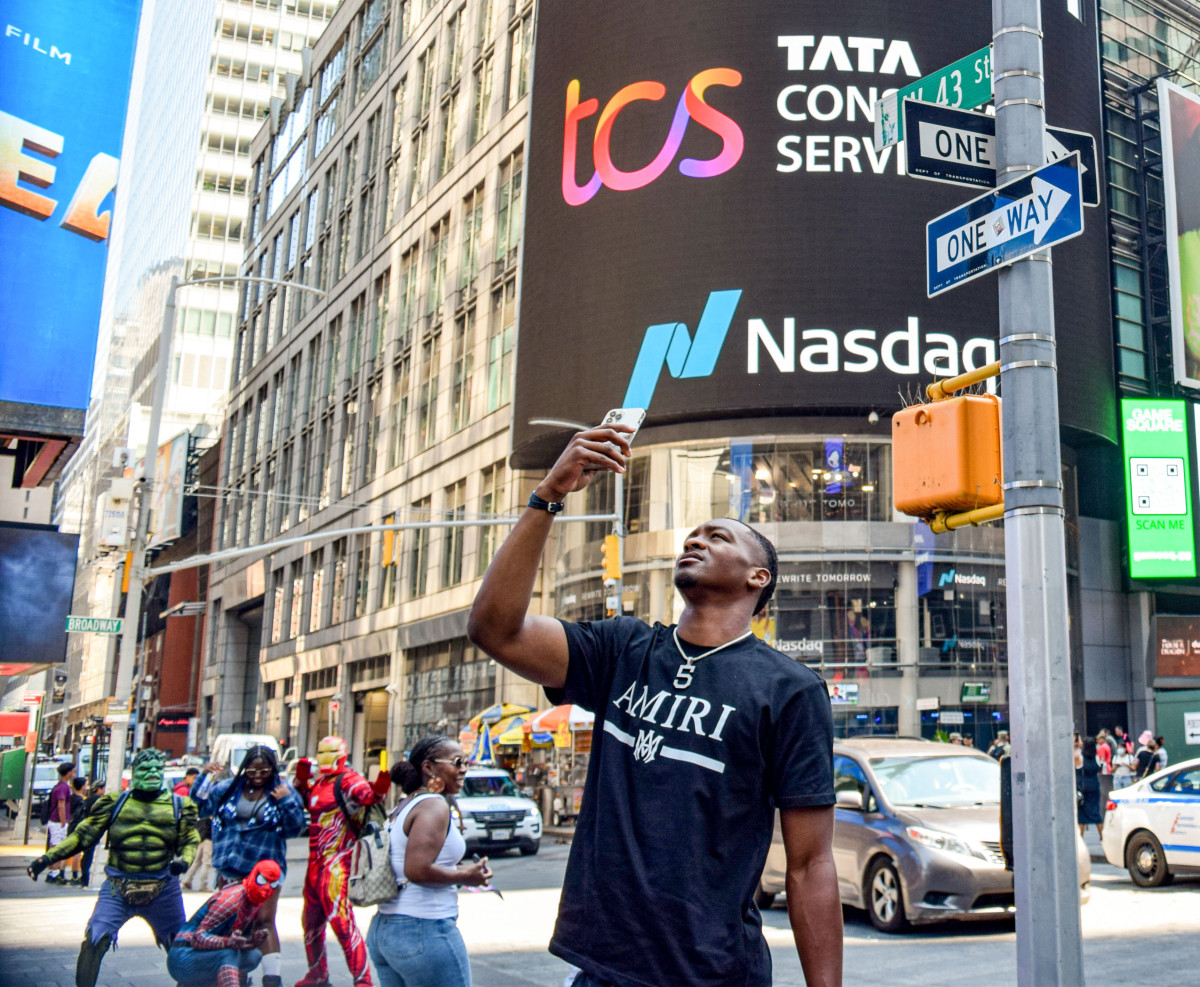The Other Side of the NIL Collective, College Sports’ Fast-Rising Game Changer
Hendon Hooker and Cedric Tillman exit a lavish Mercedes-Benz shuttle bus, guarded by a suited-up security detail and trailed by their entourages. They waltz across Times Square and glance up at a towering screen that looms at this epicenter of Manhattan.
On one of the most visible jumbotrons in the world, Hooker and Tillman are the featured act, at least for a few minutes. Their names, images and likenesses are scrawled across the giant screen that hangs over Nasdaq headquarters in a fitting snapshot of college sports’ new era.
The Tennessee football players—Hooker, a senior quarterback, and Tillman, the Vols’ top wide receiver—are whisked around the city for meetings with brands, future partners and stock market executives, arranged and paid for by the Spyre Sports Group, a marketing agency that represents the players. Spyre agents paraded the players around the Big Apple like a pair of NFL stars or Hollywood celebrities. Before they left town, they visited the headquarters of Shake Shack, met the burger joint’s CEO, Randy Garutti, and other executives and ate a few off-menu items the company’s executive chef cooked in front of them.

"A year ago, Tennessee is on probation if we do these things,” says Will Watkins, who oversees athlete and brand marketing at Spyre.
Watkins is not incorrect. The New York City visit came a mere three days before the NCAA levied allegations of recruiting violations on Tennessee’s former coaching staff for providing meals, transportation and cash to recruits—the same benefits UT athletes now receive through name, image and likeness (NIL) ventures. Though a recruit and current athlete are vastly different in the NCAA’s eyes, the juxtaposition of the two is more evidence of the peculiar era in which college sports finds itself—trapped between amateurism and professionalism.
Through a fund generated by donations from Tennessee boosters and fans, Spyre footed the bill for the players’ two-day trip to Manhattan. It is a grandiose example of a collection of fans and boosters, a “collective,” compensating athletes through NIL. Donor-led collectives are pushing the sport toward a more professionalized model, blurring the lines between endorsement contracts and employment deals.
Spyre also manages an offshoot, the Volunteer Club—believed to be one of the largest and most ambitious collectives in the country. The Club, at more than 1,000 members, distributed about $4 million to 130 Tennessee athletes this past season, most coming since January. Spyre’s goal is to raise $25 million, and officials believe it is doable.
This is a well-oiled NIL machine, led by a pair of savvy marketing agents with an office that is ballooning. Spyre is in the process of moving to a larger facility in Knoxville after a recent staff expansion. In a few short months, the company is roughly half the size of the Tennessee athletic department’s own fundraising arm.
And they want to set the record straight.
“I think there is a narrative out there and it’s been driven by one side,” says James Clawson, the company’s co-founder and CEO. “I want to change the narrative about collectives.”
But many believe collectives are exploiting a loophole, using a concept that wasn’t the intention of NIL. Leaders within the college sports industry have questioned the collectives’ motives and tactics, in many ways demonizing them for operating a pay-for-play scheme and doling out salaries to college athletes.
“They are separating professional football [those with a collective] from amateur football [those without one],” says David Cutcliffe, the former Duke and Ole Miss coach who now works for the SEC. “If you’re not into the collectives, how do you build a team?”
Even the word “collective” has acquired a connotation. A month ago, Kentucky coach Mark Stoops publicly described them as “illegal.”
“We have completely gutted the model that governed us for decades,” says Mountain West commissioner Craig Thompson. “Boosters couldn’t give a ride to a guy in the rain. Now, we aren’t giving him a ride—we are giving him the car.”
In early June, in front of about 100 business people gathered at the Covelli Centre in Youngstown, Ohio, coach Ryan Day put a price tag on his Ohio State football team. Thirteen million dollars is needed from the school’s collective to fund his roster next year, he said. Michigan coach Jim Harbaugh says his program can double that, while new Gators coach Billy Napier gave his donors a target of $20 million.
According to those with knowledge of player contracts, collectives at the elite Power 5 programs have developed a baseline of about $50,000 per football player a year. The price tag for elite recruits is often at least $100,000 in NIL salary, says LSU booster and Baton Rouge attorney Gordon McKernan, who himself will pay $500,000 in NIL deals this year.

Among the 65 Power 5–affiliated collectives, about half are deeply invested in using NIL and stand to raise more than $500 million in combined player funds by year’s end, says Opendorse CEO Blake Lawrence. That includes cash as well as comp cars, apartment rentals and free meals. “There are certain markets where athletes are on pace to out-earn their coaches,” says Lawrence.
Most collective models are similar to Spyre. Donors are paying monthly subscriptions or writing large checks for exclusive access to athletes through social media chats, event appearances or autograph signings. The more one pays, the greater the access and exclusivity. At Spyre, some pay as little as $5 a month; others have cut checks for more than $1 million, says Clawson.
The collective movement has swept across the U.S., as detailed in a Sports Illustrated story published in May. Nearly every Power 5 program has at least one collective, and the trend is reaching other entities, as well. An annual men’s college basketball tournament, the SoCal Challenge, announced last month it is forming a collective to benefit participating players.
Collectives are not exclusive to the Power 5 bluebloods, nor are they solely focused on football. Texas Tech’s collective, the Matador Club, announced last month that it is distributing $25,000 a year to each player on the football team and women’s basketball team.
Group of 5 programs are getting in on the action, too. SMU’s NIL group, Boulevard Collective, intends to pay every football and men’s basketball player $36,000 this year. It comes 35 years after the NCAA shuttered the program with the infamous “death penalty” for recruiting violations committed under coach Ron Meyer. “I bet Ron Meyer is rolling in his grave,” quips former Clemson coach Tommy Bowden.
“It’s totally changed recruiting,” Ole Miss coach Lane Kiffin says of NIL and collectives. “I joke all the time about it: Go ahead and build facilities and these great weight rooms and training rooms, but you ain’t gonna have any good players in them if you don’t have NIL money.”
Some have very little NIL money, others have a modest amount, and a select few are leagues ahead of the others with more organization and ambition. Tennessee, Miami, USC, Texas, Texas A&M and Nebraska are landing high-level college transfers and reeling in five-star high school players, many driven by individual mega-boosters or high-rolling donor collectives. The six schools are estimated to be among the biggest NIL spenders, those with knowledge of the collective industry say. And they all share a commonality—high-resourced football programs with deep-pocketed, passionate donors who are aggressively seeking to help their schools return to the glory days of yesteryear.
They are disrupting the status quo and, some believe, striking fear in those blue-blooded universities that have dominated the sport for more than a decade, such as Alabama, Clemson, Georgia and Ohio State. This spring, those frustrations spilled over into the public arena, particularly targeted at coach Jimbo Fisher and Texas A&M, which this year signed the best recruiting class in the 20-plus year history of such rankings.
During a news conference with reporters, Kiffin playfully asked if Texas A&M would “incur a luxury tax [for] how much they paid for their signing class.” In May, Alabama coach Nick Saban told a group of businessmen that the Aggies “bought every player.”
“I guess people don’t like A&M disrupting the power base of college football,” Aggies athletic director Ross Bjork says. “I don’t know why Nick Saban would say what he said except he’s threatened.”
But should he be? Will this group of top-spending programs turn their recruiting prizes into conference or national titles?
“That’s still to be determined,” Lawrence says. “If USC has a monster year in football and Miami has a big year in football, if some of the young players at Texas A&M do well, those are the story lines that will reverberate throughout the fall.
“If NIL is going to change college football, those are the story lines that must happen.”
At its start, the Spyre Sports Group was supposed to be a marketing agency only. Clawson and co-founder Hunter Baddour envisioned representing Vols athletes in a role similar to their past as agents for professional golfers. They would seek dollars from brands and businesses for endorsement and commercial ventures. But like NIL itself, Spyre evolved. Clawson and Baddour now spend most of their time seeking dollars from donors for a crowdfunding, subscription-based entity that pools funds and distributes them among UT athletes.
The fundraising effort led to their staff growing from three to eight people within a six-week stretch this past spring, and three of those were hired from Tennessee’s own fundraising arm, the Tennessee Fund.
“If you want to compete, you have to do it at the highest level or you’ll be left out of the game,” says Baddour, a 37-year-old Tennessee graduate and Knoxville native.
Some of the biggest brands in football, the most storied programs, the most iconic logos, marks and colors are all on historic slides. Tennessee last won a conference title in 1998. Miami, Texas A&M and Nebraska have yet to win a league championship since joining their current conferences. Texas is on its longest league title drought (12 years) since the 1930s, and USC has won a single league title in 13 years.
So what’s the best way back up? Money.

Spyre has raised enough capital to sign five-star California quarterback Nico Iamaleava to an $8 million contract, a figure first reported by The Athletic and confirmed by SI. In College Station, there’s The Fund, a group of donors who have silently worked in the shadows to help provide NIL opportunities to A&M athletes.
Texas and Nebraska each have multiple collectives that have distributed at least a combined $6 million to their athletes. Meanwhile, in Miami, billionaire John Ruiz has spent roughly $7 million on NIL deals with more than 100 athletes, most of them Hurricanes football players.
“The irrational passion of college sports is feeding this NIL beast,” Lawrence says.
Jim Cavale, the CEO of INFLCR, a tech company that created one of the leading content and compliance software in the NIL space, believes college sports is in a temporary stretch where certain programs are taking advantage of murky rules and little regulation. He compares it to Major League Baseball’s steroid era. “Eventually,” he says, “there will be rules.”
Whether through NIL or not, these programs have raked in the talent. Miami poached from UCLA and West Virginia for a total of four players, all starters. Tennessee won the sweepstakes for USC wideout Bru McCoy and nabbed transfers from Ohio State and Florida.
One of Texas’s collectives announced last year it was giving every offensive lineman $50,000 a year in NIL money. In the same year, the Longhorns signed three of the top 13 offensive linemen in the country. At USC, coach Lincoln Riley mined his old school, swiping Oklahoma’s star quarterback, receiver and cornerback, and landed one of the biggest transfer portal prizes this year—Jordan Addison, the nation’s best receiver in 2021 while at Pitt. A&M’s top-ranked signing class includes eight five-star prospects, the most in a single class and three more than the Aggies have signed in the previous six years combined.
Those in the collective world wonder: What’s so bad about any of this?
“We are looked at as a necessary evil, and it doesn’t have to be like that,” says Brandon Spurlock, Spyre’s fundraiser who was hired away from UT’s athletic department in April.
“The narrative comes from the athletic administrators,” Watkins says, “because they aren’t in control of it.”
Hendon Hooker stood atop the Nasdaq Stock Exchange and later witnessed the ringing of the closing bell. These were special moments, particularly for Hooker. Why?
“I’m a day trader,” he answers. Sure, Hooker is the 6'4", 218-pound quarterback who set the school record last year for passing efficiency, completed 31 touchdowns with just three interceptions and helped the Volunteers to their second winning record in the past five years. But he’s also a day-trading stock market money man. His NIL earnings have opened a whole new world, where he finds himself with a financial adviser and a manager, his sister Nile, who introduced him to the stock market.
“NIL broadens our perspective and puts us in a position to be businessmen before we enter the real world,” Hooker says.

While some argue collectives are nothing but recruiting machines bankrolling teams with a single motive (win championships), those within the collective world say they provide expansive opportunities for young people who may not advance to play professional sports. Their earning time is now.
“We’ve tried to do a good job of educating our donors in and around Knoxville of why this is so important,” says the 40-year-old Clawson. “There is a limited window for these kids.”
Hooker, in his sixth year in college, keeps his annual NIL earnings private, but it’s enough (in the six figures) to have kept him from entering the 2022 NFL draft. He earns the cash by satisfying about 10 public appearances each year, as well as signing memorabilia. Athletes at Spyre make anywhere from $1,500 to six figures annually, Clawson says.
Unlike many collectives, Clawson’s group does not distribute NIL funds evenly across teams. “You can’t point to any other industry that does that,” he says. The most difficult thing about NIL, Hooker says, is “learning how to say no.” With class and training schedules, he can’t do it all. He took three days off from offseason workouts to travel to New York for this mid-July trip, something coach Josh Heupel approved after a brief shock.
“He was like, ‘Three days you’ll be gone?!’” Hooker recalls. “But he understands.”
The cash UT’s athletes earn “indirectly speaks to recruits,” says Clawson.
For many athletes, NIL has been a financial windfall like they’ve never seen. Georgia coach Kirby Smart says one of his players, offensive lineman Micah Morris, is supporting his father on dialysis with NIL money. At Florida State, a player’s mother no longer has to work three jobs because her son sends NIL earnings home, says Matt Quigley, a longtime booster who is in real estate and now guides FSU’s Rising Spear.
“It’s about time they’re allowed to profit,” Quigley says. “They’re risking life and future longevity and can’t be compensated for that? It made no sense.”
The opportunities go beyond cash offers. For instance, this was Tillman’s first trip to New York City. A Manhattan first-timer, the All-SEC receiver got to eat his first slice of New York–style pizza—the thin-crusted, coal-fired pie from John’s Pizzeria. After lunch, the shuttle bus motored up 8th Avenue when a giant structure loomed outside the driver’s side window.
“What’s that?” Tillman asks.
Someone answers, “That’s Penn Station.”
“See,” Baddour says, “that is what it’s all about.”
Though the NCAA’s amateurism facade has mostly crumbled under the weight of legal challenges, rules still exist, for now. Earlier this summer, the organization’s enforcement staff visited Miami to conduct interviews as part of what’s being termed an “inquiry.” NCAA investigators have made inquiries with Tennessee as well, but the organization has not reached out to Spyre.
Of the many threats to the existence of collectives—sustained fundraising, athlete employment, federal NIL regulation—the NCAA presents the biggest obstacle if the association seriously sanctions schools for not policing their boosters and collectives. Many believe such sanctions will end up in a court battle—the NCAA vs. boosters.
“We have three law firms that we work with. We’ve not done anything without a lot of people signing off on it,” Clawson says. “We have been really careful on making sure we’re on the right side of the state law and NCAA rules.”
The NCAA’s prying further fuels the narrative around these booster-led groups. Are they good for the game? Will they ultimately survive? Are they … legal?
Many expect the end of this evolution will come with schools paying athletes as employees and/or sharing revenue with them, but there still remains a place for collectives and marketing agencies to provide them with a second stream of revenue, says Spurlock, Spyre’s 37-year-old who oversees fundraising. That’s the case in the NFL, where players supplement their salaries with endorsement contracts.
Spurlock acknowledges that he took an awful risk leaving Tennessee’s athletic department and joining the company in April. He worked as a college administrator for more than a decade, with stops at Western Kentucky, Boston College and then his alma mater, Tennessee. He seemed to be on a promising upward trajectory in the industry.
“We don’t know what’s coming a week, a month, a year from now. It’s changing by the day,” he says. “But there’s a path for us no matter what happens.”
Though their confidence in their future is high, Spyre officials are exploring ways to operate a more sustainable model. Instead of relying on a handful of millionaire boosters to annually fund the operation, they hope to gain thousands of more subscribers, each giving a modest amount every month.
However, in this unique era of college sports, when decades-old amateurism rules have been eschewed, raising such funds presents a problem. “We are still talking to people today that can’t believe we can do what we can do,” Clawson says.
Donors who have contributed for years to a school are also being asked to contribute to a second entity. “Last thing we want to do is to steal dollars. But this is a new way to give,” Baddour says.
Some question the sustainability of boosters donating money to a collection for, in many cases, athletes who have never played a down of college football and can transfer freely.
“Do we want a new weight room or do we want to spend it on a 17-year old who may or may not pan out?” asks Greg McElroy, the former Alabama quarterback who is now an ESPN analyst.
Ruiz, the billionaire Miami booster, says he’s unsure if he’ll keep signing so many athletes to NIL deals, expecting such deals will lose their value after their inaugural year. “Next year, it becomes standard,” he says. “People pay less attention, so you get less return on your investment.”
While fundraising for this athlete NIL pool, Spyre and other collectives must walk a tightrope with their own university. This is a delicate dance on both sides. Schools are prohibited from involving themselves with booster-led groups supporting NIL. Tennessee must distance itself while also providing a level of oversight that keeps NCAA investigators away. There exists “friction” between some athletic departments and their collectives, Baddour says. He claims that isn’t the case with Tennessee and Spyre. But that relationship has been tested over the last several months, when at times communication breakdowns have caused angst.

While it is against NCAA rules and some state laws to offer inducement via NIL, such moves are happening across the landscape. Collectives and boosters are using NIL funds to (1) poach players from other teams, (2) retain their own players from being poached and (3) recruit athletes out of the transfer portal or high school ranks.
Many of them are brazen about it. Just last week in fact, the president of Arizona State’s new collective, Sun Angel, told AZCentral.com that one of its goals is “attracting top talent.”
In a way, Clawson and Spyre control the gears on Tennessee’s roster. At one point, he even refers to it as a “general manager” type role. His phone often buzzes with Vols athletes seeking better deals, either because another school is after them or because players have read about big-money deals other players are receiving—many of which, he says, aren’t real.
NIL numbers are being inflated, Spyre officials say. Many others within the industry agree. “There’s a lot of false numbers thrown around out there,” says Baddour.
A story anonymously shared with SI reveals such. This past recruiting cycle, an ACC school was approached by the agent of a player requesting his client be paid $1 million a year to sign with the school. The player ultimately signed with the program for roughly one-fifth that much.
In another recruiting tale, one prospect’s agent told School A’s coaching staff that School B was offering $100,000 a year. A coach from School A contacted a coach from School B.
“Are you guys offering $100,000?” he asked.
“No,” the coach at School B told him, “but we were told you were offering $100,000.”
During McElroy’s recruitment in the mid-2000s, a prospect chose a school based on path to the pros, proximity to home, a team’s history of success and campus life. Now? “For a vast majority, NIL is the No. 1 priority,” he says. And yet still, McElroy doubts that the big-spending NIL schools will suddenly overtake the upper echelon of the sport. “The Yankees have the highest payroll in baseball, but they don’t win the World Series every year,” he says.
There is a downside to amassing a team based on NIL alone, coaches say. Unequal pay could result in locker room problems. Players earning lofty NIL salaries might not find playing time or may transfer after a short period with the team. Will there be entanglements between boosters and coaches on the management of the roster? After all, at many places, the donors who once only funded facilities and coaching salaries are financially backing a roster.
“I think you’re going to see some people really crash,” says Cincinnati coach Luke Fickell. “Everything is about money, and I don’t think we’re ready for that.”
A football roster is 85 players deep. There can be only 22 starters, and most teams during a full game don’t play much more than 55 guys. “Just because you gave somebody a lot of money doesn’t mean they play,” says Gerry DiNardo, the former LSU and Indiana coach who works for the Big Ten Network. “What happens if they are spending money on the wrong players?”
Such is life. How many high NFL draft picks have ultimately fizzled? As is the case in recruiting now, those who evaluate and identify properly will have fewer busts and more victories. And wouldn’t you know it, those same programs are the richest in the sport.
Andy Schwarz, an economist specializing in sport economics, says NIL will not alter a recruiting landscape or impact parity that already trends toward the wealthy. From 1998 to 2020, six teams won 74% of the football national championships: Alabama (six), LSU (three), Clemson (two), Florida State (two), Florida (two) and Ohio State (two). Five of the six are not only inside the top 12 nationally in pre-pandemic ’19 athletic budgets but have reeled in the best talent in the nation over the last decade, according to recruiting rankings.
DiNardo doesn’t expect a noticeable change at the top. “I am a firm believer that college football is a have-and have-nots business, and regardless of how the rules change, it will never make a have a have-not and will never make a have-not a have.”
But what of these ambitious collectives in Knoxville, Miami and College Station? “Maybe those are the groups that will move the needle,” he says.
Plenty of questions still linger. But one thing is evident from the scene in Times Square: College athletes are no longer amateurs.
Encircled by marketing agents, NIL fundraisers and Nasdaq team members, Hooker and Tillman posed for photos with their images and Twitter names scrawling across that giant screen above. A man, sauntering toward one of their security guards, points toward the two players: “Who are they?”
NFL standouts? NBA stars?
“They are football players,” he’s told, “from Knoxville, Tennessee.”
More College Football Coverage:
• 40 Observations on the College Football Schedule
• The Direction of College Athletics Hangs in the Balance
• Most Intriguing Coaches of 2022 Season
